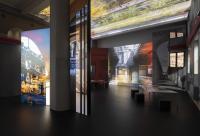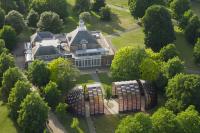The Met
Bangkok, Thailand
This project investigates creative ideas for high-rise, high-density living in the tropics. This project explores how aspects of low-rise tropical housing can be adapted to provide high amenity through indoor-outdoor spaces in the sky.
Most tropical high-rise housing in developing countries replicate cold-climate models, with sealed facades and total reliance on air-conditioning. However, in the tropics, light winds, year-round balmy weather, constant temperatures and high humidity make outdoor living desirable. In addition, the environmental conditions up high in dense Asian cities are preferable to those near the ground – there is more privacy, better views, lower humidity, stronger breezes, better security, less noise and less dust. This development creates enjoyable tropical living conditions at extremely high densities – a plot ratio of 10:1. Located between two train stations, the development permits higher use of existing infrastructure, and a practical way of dealing with Bangkok’s urban sprawl and terrible traffic jams. In Bangkok public transport is used by all sectors of society, as it is often the only way to move through the grid-locked city.
The design is inspired by Thai forms – ceramic tiles, textiles and timber paneling, abstracted and used as a way to organize forms. The cladding, for instance, uses temple tiles as an inspiration, while the staggered arrangement of the balconies recalls the Thai teak staggered paneling on traditional houses. The walls incorporate random inserts of faceted polished stainless steel, a contemporary interpretation of the sparkling mirrors incorporated into Thai temples, returning this delightful glittering effect at a scale appropriate to the vast central city.
The design achieves tropical houses in the sky with breezeways, full exposure to light and views, outdoor living areas, planters and high-rise gardens, and open-air communal terraces with barbeques, libraries, spas and other facilities. These sky terraces, both private and public, link the blocks every 5 storeys, creating dramatic yet human-scaled external spaces in the sky.
The building is planted on every horizontal surface. Additionally, vertical faces are shaded by green creeper screens, rising up the full 66 storeys. Balconies are provided with private planters. All apartments are cross ventilated, and all face north and south. The staggered block arrangement gives all apartments access to light and air on all four sides. The design encourages and makes possible living without airconditioning.
Common areas are spread throughout the towers, offering inhabitants a variety of experiences, from the intricately designed carpet of water, stone and vegetation at ground level, to the extensive indoor-outdoor facilities at the pool level, to libraries, barbeques, and function areas at sky terraces that share the spectacular views from the highest floors among all the inhabitants.
Structural engineering is fully integrated with architectural design. Built on a regular 9m module, the structure works well with all the various functions – apartments, recreational facilities and car parking. Wind tunnel tests were carried out to ensure safety and comfort in sky terraces. Structural bracing was introduced at every 5 levels, which is used for sky gardens, private pools and common areas. As loads accrue, the columns enlarge on the exterior of the building, creating protected indoor-outdoor spaces for balconies and terraces, and allowing apartment layouts to be standardized, even at lower levels. These exposed buttress columns are both structurally rigorous as well as an architectural expression.
These ribs are lit at night, turning the large building into an elegant, vertical screen. The sky gardens are also highlighted with lighting. The orderly, elegant building makes an attractive addition to the chaotic skyline of Bangkok. With its openings to the sky behind, planted facades, balconies and sky gardens, the Met weaves nature into the concrete jungle of central Bangkok.
The design is an innovative solution to the issues of density in tropical Asian cities, and offers a new model for high-density tropical housing. The model of a naturally ventilated, perforated, indoor-outdoor, green tower is a necessary alternative to the sealed, glazed curtain wall buildings being erected across the tropical regions.














